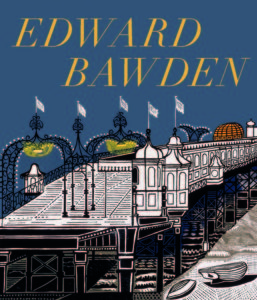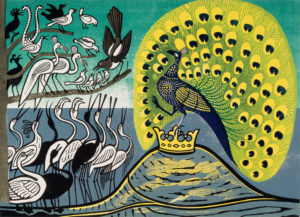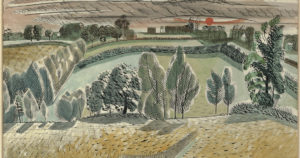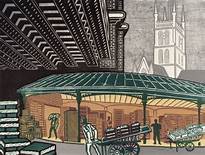 Dulwich Picture Gallery’s summer show is of the twentieth century English artist and designer, Edward Bawden, part of its Modern British painters programme. I went along last week to catch it before it closes on 9th September, 2018.
Dulwich Picture Gallery’s summer show is of the twentieth century English artist and designer, Edward Bawden, part of its Modern British painters programme. I went along last week to catch it before it closes on 9th September, 2018.
Bawden was friend to Eric Ravilious, whom he met on the first day they both began at the Design School of the Royal College of Art ( both of them with scholarships, both Essex born and from Non-conformist backgrounds ) and a fellow pupil of Paul Nash. The waves in Bawden’s seaside pictures owe much to his tutor’s studies of Dymchurch, his watercolour style and love of pattern is like Ravilious’. He was part of that group of artists who settled at or around Great Bardfield in Essex – Ravilious, his wife Tirzah Garwood, John Aldridge, John Nash (Paul’s brother nearby at Wormingford) and the potter Charlotte Epton, Bawden’s wife. Bawden painted Brick House and its garden and the countryside around and several of these fine and atmospheric paintings are on display in the exhibition.
There are plenty of paintings, usually in water colours, to see, but also a lot of Bawden’s other artwork. These range from wallpaper, through maps commissioned by Frank Pick of London Underground, to beer mats for Gilbeys Gin and many book covers and illustrations. It was through the illustrations that I first encountered Bawden in books from the 1950s given to me in childhood by an uncle. Later I saw some of his commercial work, like the famous ads for Fortnum & Mason. I had never seen, and last Friday was intrigued by, his amazing maps and portmanteau pictures; so full of ingenious detail and puckish humour and now, for me, typical of Bawden’s art.
Words like ‘puckish’ spring to mind when describing some of his work – the jolly and refined vocabulary of inter and post WWII England. He and his work inspire affection, as Ravilious does, for an England of  downland walks, warm beer in country pubs, steam trains and Victorian engineering. But there is more to Bawden than nostalgia (as there is to Ravilious). He experimented with new techniques like collage, he was a master draughtsman as well as a superb designer of linocut. The wonderful outlines of London, its markets and stations are well-known as are those of Brighton pier and they feature here. He also designed tiles – most famously the Ferry Across the River Lea tile design at Tottenham Hale underground station and the profile of Queen Victoria at Victoria.
downland walks, warm beer in country pubs, steam trains and Victorian engineering. But there is more to Bawden than nostalgia (as there is to Ravilious). He experimented with new techniques like collage, he was a master draughtsman as well as a superb designer of linocut. The wonderful outlines of London, its markets and stations are well-known as are those of Brighton pier and they feature here. He also designed tiles – most famously the Ferry Across the River Lea tile design at Tottenham Hale underground station and the profile of Queen Victoria at Victoria.
An avowed aim of this exhibition is to display the range of Bawden’s work and in this it certainly succeeds. In addition to the maps, a revelation for me was the series of war-time portraits he drew and painted when an official war artist – the subjects were largely of non-white men serving in various armed forces and of locals in Baghdad and Addis Ababa, he spent much time with the marsh arabs of southern Iraq. Timeless in technique, unusual, for the time, in subject matter, these could be modern portraits.
painted when an official war artist – the subjects were largely of non-white men serving in various armed forces and of locals in Baghdad and Addis Ababa, he spent much time with the marsh arabs of southern Iraq. Timeless in technique, unusual, for the time, in subject matter, these could be modern portraits.
Bawden was an original, his own man, as well as the product of his time, who loved the process of creation as much as the finished article. One also gets the sense that he was intensely private. Peyton Skipwith, his friend and dealer, writes, in the Preface to the catalogue which accompanies this exhibition (£25) that Bawden never talked about Ravilious, after that artist’s untimely war-time death, concluding that he was deeply scarred by it. Not for him the incorporation of his own life in the works for public display, he was, simply, too professional, though his wry observational humour shines through. I could find no darkness in Bawden, though his weather/season paintings are atmospheric. The blocked perspectives, or disquieting angles one finds in some Ravilious works are absent in Bawden. What this says about him as an artist I do not know.
Edward Bawden continues at Dulwich Picture Gallery until 9th September, admission £15.50 (£8 concessions). It is certainly well worth a visit.
For more on art try All Too Human Frida Kahlo The Jameel Prize Lin Mae Saeed – Biene


 RSS – Posts
RSS – Posts